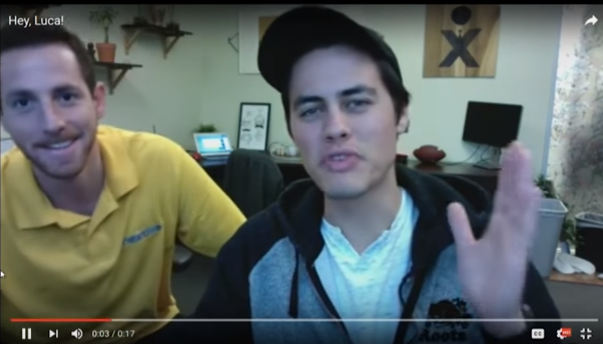5 Inbound Marketing Hacks Your B2B Company is Missing Out On
There’s a common misconception that B2C marketers get to have all the fun. Learn how to kick off your B2B marketing shackles and grow your business with these five inbound marketing hacks, taken from six proven case studies with your peers.
Hack #1. Cannibalize your content
When it comes to content marketing, robbing Peter to pay Paul isn’t going to get you fired. It might even get you promoted.
If robbery and cannibalism harsh metaphors for you, consider it recycling. Saving your marketing team’s environment one piece of content at a time.
When your social media team creates a cool and valuable infographic, don’t just let it die after it moves down the Facebook wall. Shock some electricity into it, call it reborn, and send it out in an email send. Build a blog post around it. Heck, build a white paper around it and drive downloads.
A great example of this tactic is what SAP was able to do in building a full complement of industry-specific white papers, infographics, blogs, surveys, presentations and email promotions for its 19 industries.
While the customer-focused team at SAP wanted the content to be specific to each industry, within that industry, they wasted nothing and converted information to appeal to people’s different preferences for digesting information.
Read the full case study: Inbound Marketing: How SAP drove 9 million impressions with targeted content campaign
Hack #2. Remember that you’re talking to a person, not an entity
When developing campaigns, remember that while you technically cater to businesses, you’re actually talking to one, or maybe just a handful of people.
In other contexts, they’re B2C consumers, and are beginning to expect that type of human-to-human communication from you as well.
Take Nextiva, a cloud-based communications company, that deals with companies that range from “your local mom and pop shop to fortune 500 companies with thousands of employees,” according to Max Anderson, Video Producer, Nextiva.
The company dedicated itself to stellar customer service as a way to set it apart from competitors, which they found difficult to do over the phone. So Nextiva decided to break the barriers of traditional B2B customer service and began recording personalized videos.
“In today’s digital age, it has become increasingly hard to provide a level of face-to-face interaction, and we have found that our video responses have helped bridge that gap,” Max said.
Nextiva’s video strategy consists of content that ranges from a simple, quick video response to customers from a web camera, to professionally produced videos focusing on topics such as customer success stories, Nextiva culture, how-tos called “Pro Tips” and common customer questions.
“Face-to-face interaction is not only important in putting a name to the face, but it also helps to provide a feeling of importance. The customer knows that they aren’t just a number to us,” Max said.
Video at the company began as an informal way to speak to customers directly. A customer would send a message, usually containing a question or in regards to a support call experience.
Then, a Nextiva employee records a short, personalized video addressing the comment or question and replies directly. If possible, when replying to a positive comment, they like to get the employee referenced into the video to show the direct impact that customer made, and help them put a face to the name.
Even though only one person sees the video responses, he added, “the impact is huge. You really build that company culture, and [customers] start to embrace your company even more.”
Read the full case study: Inbound Marketing: How a cloud-based communications company grew to over 1,000,000 YouTube views in four years
Hack #3. Borrow ideas from your B2C comrades
There’s a common misconception that B2C marketers get to have all the fun. But as the tone of B2B marketing relaxes and relies more on humanizing tactics, that’s all changing.
A great example of borrowing from the B2C experience is found with ecommerce bulk book provider BookPal, which found an opportunity to vastly improve its customer experience in a sudden customer-base expansion.
“[We are] constantly looking at ways to further improve how we interact with those customers,” said Tony DiCostanzo, President, BookPal.
After conducting a website audit and building out detailed customer personas, Tony and his team decided to analyze the B2C retail experience their customers might be having, as the third step of a complete website redesign.
“We looked at, ‘What is the experience like for that person when they shop … Nordstrom, a Pottery Barn and other retailers in the consumer space?’ So that, ultimately, the decisions we made on our own site from a design and functionality standpoint would be very familiar to them when they approach our store having tremendous experience shopping at other retailers,” Tony said.
That analysis meant including social media — BookPal currently has a blog, Facebook, Twitter, Instagram, Pinterest and even recently began using Snapchat to see if it could potentially be an appealing platform for customers.
“We do play in that social media space, I think, more predominately than other B2B retailers,” he said.
DiCostanzo said understanding how customers use these platforms will provide increasing returns as younger members of the business community continue to escalate in their jobs and play more active roles in their companies.
Adopting some of these more typically B2C practices makes sense in the B2B sphere, Tony said, because “ultimately, they’ve driven revenue growth for the B2C store and giving [customers a] similar experience removes those friction points to making a purchase decision.”
Even though B2B customers might be utilizing their employer’s checking account versus their own, he added, “You want to give them an experience that resonates with what they’re familiar with and rewards them for similar behaviors.”
Read the full case study: B2B Marketing: Customer-focused site design for book ecommerce drives order volume up 211% in three years
Hack #4. Get your customers to do the work for you
Content creation is hard work, so why not reach out to your customers for it? Especially when it can add tremendous credibility and creativity.
Take HCSS, a construction software company MarketingSherpa has written two case studies with. The first shows a team so full of customer-first marketing talent, and yet, have so much rich opportunity for more, that I am comfortable calling them the Beyoncé in Destiny’s Child of leveraging client stories into content.
The second, (our Best-in-Show this year for MarketingSherpa Summit) is Beyoncé in Lemonade — the HCSS team working at the height of their game, and with a rabid fan base that nearly idolizes them.
How did they reach Beyoncé-level marketing?
Years of working up to it of course, but the big ah-ha is when the team decided to bring customers into the process. To break down whatever barriers keep marketers and their customers apart.
It started with the team struggling to get that level of transparency from their customers. HCSS customers use the company’s software to actually win construction contracts, and while the team heard about success stories, they were having a hard time getting anything usable.
The HCSS marketing team wanted a way to have these stories at hand, not sounding “too marketing-driven”, but actually in the customer’s own words.
“We’re the market leader, but we still have a lot of area to grow,” said Dan Briscoe, Vice President of Marketing of HCSS’ more than 4,000 customers. “We want to do things that create brand awareness and really engage our customer base.”
One issue with that objective is that the typical HCSS customer isn’t tech savvy with social networks or getting online.
Kara MacDonald, Marketing Manager, HCSS, added that “one of the struggles that we’ve had in the past with getting these stories is [our customers love] to tell you sitting there at lunch but the minute you want to start interviewing, they freeze up.”
They decided to play on customers’ sense of pride and competitive nature by creating the March Madness-style “Most Interesting Project Bracket Challenge.”
The entries came in so quickly that the team had to not only expand the bracket to fit 120 projects, but ended up creating an entire website around it. Customers actually use the website to sell themselves to their potential clients.
Read the full case study: How HCSS used an interactive contest to increase web traffic 800%
The success of that project lead to a new level of content marketing for HCSS. They quit the sales and marketing game all together — which of course, made them that much better at it.
Originally, the idea was to, “simply put, to get over ourselves. To quit the sales and marketing obsession to focus only on our company, to talk only about ourselves, and to quit trying to show how innovative our products are and how beloved our customer support is across the industry. Nobody really cares, and when they do care, they don’t want to hear it from us,” Dan said.
Once HCSS learned to make the customers the true hero of its stories, “it transformed our world,” he said. “It took several iterations and a constant struggle against talking about how much our customers love our software before we finally broke free. But once we did, we flew.”
The campaign the team developed wasn’t just around their customers, but was driven by a desire to uplift the entire construction industry.
Briscoe and his 22-person team put together the “I Build America” campaign with the tagline, “Pride. Respect. Construction” that has seen several website iterations, project awards, an ambassador program, meaningful social media, content production and giveaways.
Funnily enough, he added, since they stopped focusing on sales, each quarter sets a new record. The marketing team has doubled, and the focus on the customer as a hero has had a permanent imprint on company culture.
Read the full case study: Inbound Marketing: 14% event attendee participation from New Relic’s social media campaign
Hack #5. Push the work off on your colleagues
When United Capital, a private financial life management company, rebranded its weekly newsletter to focus on the prospect journey, the change also included integrating original content authored by internal subject matter experts, instead of only curated content.
To pull together subject matter experts (SME), Christina Martin, Vice President, Digital Marketing, United Capital, and her team assembled a cross-functional and content-steering committee of multiple disciplines within the organization.
“Companies like ours have subject matter experts all over the place, but those people aren’t necessarily writers and their job isn’t necessarily to write content,” she said.
The committee meets monthly, reviewing the next two upcoming months of content.
“We talk about the marketing campaigns that are coming up and brainstorm on content that would support the marketing campaigns or the overall editorial charter, and then identify SMEs and have the SMEs work with writers,” she said.
By integrating original content authored by internal subject matter experts, instead of including only curated content, the digital marketing team was able to increase newsletter engagement by 145% in one year.
Read the full case study: Email Marketing: How integrating original blog content spurred a 145% engagement increase in rebranded weekly newsletter
You might also like…
B2B Marketing: How Optum developed a distinct social identity with a thought leader approach to content and social media channels
Email Marketing: How integrating original blog content spurred a 145% engagement increase in rebranded weekly newsletter
B2B Marketing: How an accounting solutions firm uses a daily digest newsletter with industry content to build trust with audience
Categories: B2B Marketing b2b, content, H2H, human to human marketing, Inbound Marketing, SEO, social media, video marketing











